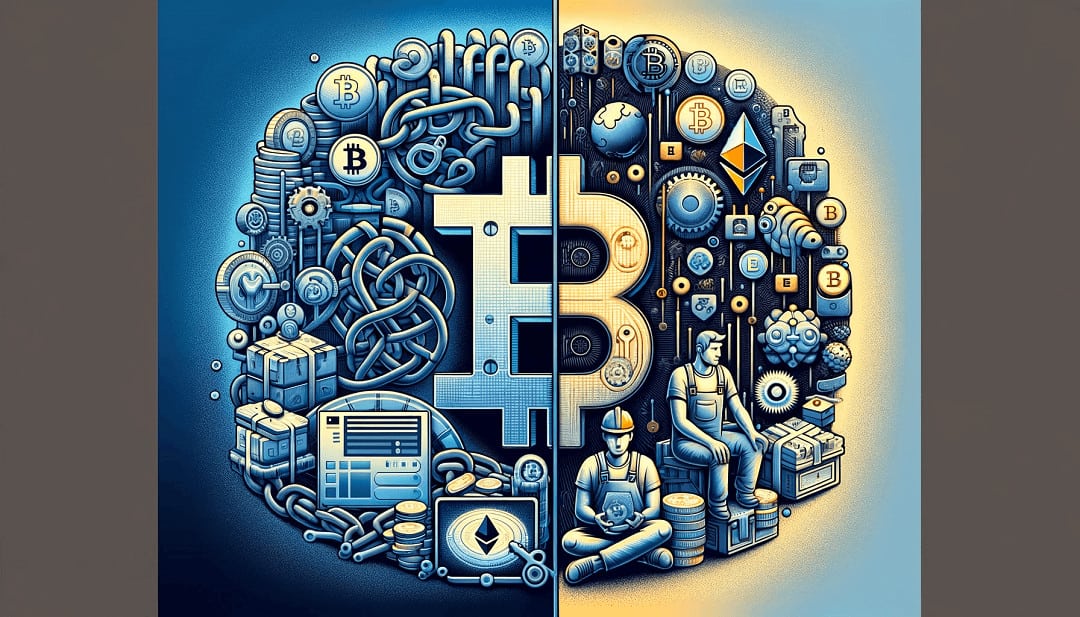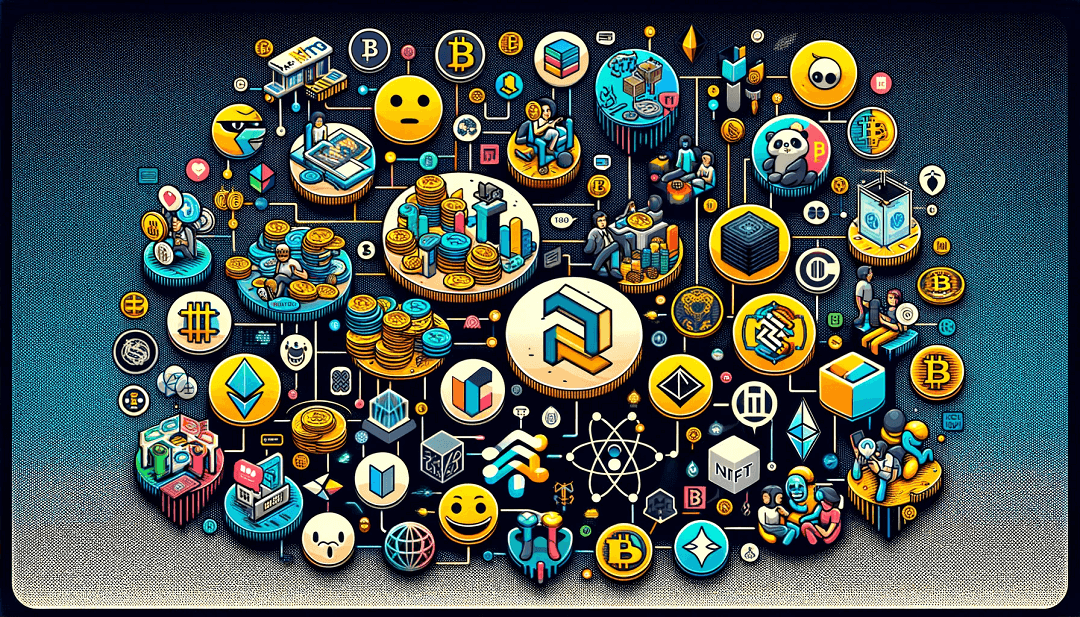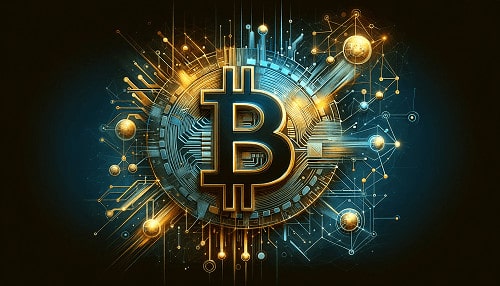In the rapidly evolving world of cryptocurrency, the emergence of BRC-20 tokens marks a significant milestone, heralding a new era of innovation and utility on the Bitcoin blockchain. These tokens, built on the foundations of one of the most revered cryptocurrencies, extend the capabilities of Bitcoin far beyond its original design. This article delves into the intricate world of BRC-20 tokens, unraveling their technical intricacies, diverse applications, and the transformative impact they are poised to have on the broader crypto ecosystem. As we explore the cutting-edge platforms and projects leveraging these tokens, we unveil how BRC-20 is not just a token standard but a gateway to a new frontier in blockchain technology.
What Are BRC-20 Tokens?
BRC-20 tokens represent a groundbreaking class of digital assets designed to operate on the Bitcoin blockchain. Traditionally, Bitcoin’s primary role has been as a digital currency for peer-to-peer transactions. However, the introduction of BRC-20 tokens marks a significant evolution in its capabilities, opening the door to a plethora of functionalities that were previously the exclusive domain of platforms like Ethereum. BRC-20, a token standard similar in concept to Ethereum’s ERC-20, allows for the creation and deployment of tokens that can represent a wide range of assets and values. These tokens can be anything from simple currency-like tokens to more complex representations of physical assets, digital services, or even shares in a company. This versatility has been instrumental in broadening the scope of Bitcoin’s utility, transforming it from a mere cryptocurrency to a more expansive and versatile blockchain platform.
The architecture of BRC-20 tokens is crafted to harmonize with the existing infrastructure of the Bitcoin network. This compatibility is key, as it ensures that these tokens can leverage Bitcoin’s robust security and widespread adoption without necessitating significant alterations to the core blockchain. Each BRC-20 token operates as a digital contract, stipulating the rules and functionalities unique to that token. This can include aspects like the total supply of tokens, how they can be transferred, how transactions are approved, and how data is accessed. These features are encoded into the blockchain, providing a transparent and immutable set of rules that govern the token’s behavior. The introduction of BRC-20 tokens is a testament to the flexibility and adaptability of the Bitcoin blockchain, demonstrating its potential to go beyond a simple payment system and become a foundational layer for a wide array of digital assets and applications.
The Technical Backbone of BRC-20 Tokens
The technical framework of BRC-20 tokens is an intricate blend of Bitcoin’s existing blockchain architecture and smart contract functionalities, a synergy that was not inherently designed into Bitcoin’s original protocol. At the core of BRC-20 tokens is the concept of smart contracts, which are self-executing contracts with the terms of the agreement directly written into code. Unlike Ethereum, which was built with native support for smart contracts, the Bitcoin blockchain initially lacked this feature. The implementation of BRC-20 tokens, therefore, required innovative solutions to integrate smart contract capabilities into Bitcoin’s existing infrastructure. This was achieved through various methods, including the use of overlay networks or sidechains that operate alongside the main Bitcoin blockchain. These additional layers interact with the primary blockchain to execute complex operations, enabling the creation and management of BRC-20 tokens without disrupting the efficiency and security of the Bitcoin network.
In terms of operation, BRC-20 tokens function through a set of predefined rules encoded into their smart contracts. These rules determine various aspects of the token’s behavior, such as how they are minted, how they can be transferred, and how transaction fees are handled. For instance, a BRC-20 token can have a fixed supply, meaning that only a certain number of tokens will ever exist, or it can have a flexible supply mechanism, allowing for the creation of new tokens under specific conditions. The transactions involving BRC-20 tokens are recorded on the Bitcoin blockchain, leveraging its decentralized, tamper-resistant ledger. This ensures that all transactions are transparent and immutable. Furthermore, the security model of the Bitcoin blockchain, which is renowned for its resilience and robustness, extends to the BRC-20 tokens, thereby inheriting a high degree of security against attacks and fraud. The technical implementation of BRC-20 tokens on the Bitcoin blockchain is a testament to the blockchain’s versatility and adaptability, showcasing its capacity to host a diverse range of applications and assets beyond its original design.
Comparing BRC-20 with Other Token Standards
The emergence of BRC-20 tokens within the cryptocurrency ecosystem presents an intriguing point of comparison with existing token standards, most notably Ethereum’s ERC-20 and Dogecoin’s DRC-20. While these standards share the fundamental purpose of token creation and management, their underlying blockchain platforms and inherent functionalities exhibit distinct differences. ERC-20, the most widely used token standard in the cryptocurrency space, operates on the Ethereum blockchain. It set the benchmark for the creation of digital tokens, providing a standardized set of rules and protocols that ensure interoperability among Ethereum-based tokens. ERC-20 tokens are inherently designed to function within Ethereum’s ecosystem, leveraging its native support for complex smart contracts and decentralized applications (DApps).
In contrast, BRC-20 tokens bring this concept of standardized digital assets to the Bitcoin blockchain, a platform initially not designed for such a level of complexity. The integration of BRC-20 tokens into Bitcoin’s ecosystem signifies a significant technological leap, bridging the gap between Bitcoin’s robust but somewhat limited functionality and the versatile nature of smart contract-enabled platforms like Ethereum. One of the unique features of BRC-20 tokens is their reliance on Bitcoin’s highly secure and proven blockchain infrastructure. While Ethereum’s blockchain is designed for flexibility and programmability, Bitcoin’s blockchain is lauded for its unparalleled security and stability. BRC-20 tokens, therefore, benefit from the strong security foundation of Bitcoin, while introducing a level of versatility and functionality that was previously exclusive to platforms like Ethereum.
Furthermore, BRC-20 tokens potentially offer a more streamlined and energy-efficient approach to token management and execution, given Bitcoin’s simpler consensus mechanism compared to Ethereum’s complex smart contract execution environment. This can result in faster transaction processing and lower fees, making BRC-20 tokens an attractive option for certain use cases. However, it’s important to note that the BRC-20 standard is still evolving, and its full potential and limitations are being explored as it continues to be adopted and integrated into various projects and applications. The development of BRC-20 tokens represents a significant milestone in the cryptocurrency world, as it blends the security and reliability of Bitcoin with the innovative and flexible functionality of tokenization, a feature that has been predominantly associated with Ethereum and other similar platforms.

Key Use Cases of BRC-20 Tokens
BRC-20 tokens, with their integration into the Bitcoin blockchain, open up a realm of innovative applications that leverage the strengths of Bitcoin’s network while introducing new functionalities. One of the primary use cases for BRC-20 tokens is in the realm of digital asset tokenization. This involves the representation of real-world assets, such as property, art, or commodities, in a digital form on the blockchain. The inherent security and immutability of the Bitcoin blockchain make it an ideal platform for tokenizing assets, ensuring that the ownership and transfer of these digital representations are secure and transparent. For instance, a piece of real estate can be tokenized into multiple BRC-20 tokens, allowing for fractional ownership and easy transferability. This not only democratizes access to investment opportunities that were traditionally available to only a select few but also enhances liquidity and market efficiency for such assets.
Another significant application of BRC-20 tokens is in the domain of decentralized finance (DeFi). DeFi platforms aim to recreate traditional financial systems, such as banks and exchanges, in a decentralized manner on the blockchain. BRC-20 tokens can be used to create decentralized lending platforms, stablecoins, or yield farming protocols, all operating on the robust and secure Bitcoin network. This integration of DeFi functionalities with Bitcoin’s blockchain could potentially attract a broader user base, given Bitcoin’s widespread recognition and trust. Additionally, BRC-20 tokens can be utilized for creating governance tokens, which allow token holders to participate in the decision-making processes of decentralized organizations or protocols. This use case harnesses the power of blockchain to foster a more democratic and transparent system of governance in various decentralized projects.
The flexibility of BRC-20 tokens also extends to other areas such as gaming, supply chain management, and digital identity verification. In gaming, BRC-20 tokens can be used to represent in-game assets, such as weapons, characters, or virtual land, which can be traded securely on the blockchain. For supply chain management, BRC-20 tokens can enable the tracking of products from the manufacturer to the end consumer, enhancing transparency and trust in the supply chain. In terms of digital identity, BRC-20 tokens can provide a secure and immutable way of verifying individual identities and credentials, which is crucial in an increasingly digital world. These diverse applications underscore the versatility of BRC-20 tokens, positioning them as a significant tool in the ongoing evolution and expansion of blockchain technology’s potential.
Popular Platforms and Projects Leveraging BRC-20
The BRC-20 token standard has garnered attention with various projects and platforms adopting it for their unique use cases. One such project is Pepe, which has emerged as a significant player in the BRC-20 space. Pepe is not only one of the largest BRC-20 tokens by market value, exceeding $445 million, but it also delivered a staggering 39,000% return in its first month. Pepe’s popularity stems from the anticipation that it might become the next big meme coin, following in the footsteps of Dogecoin and Shiba Inu.
Another notable BRC-20 token is VMPX. Launched by XEN crypto founder Jack Levin, VMPX is a meme token primarily used for entertainment and gambling. Despite not offering any specific function or benefit, it has captivated the interest of crypto enthusiasts and gamblers, trading at a market value of about $15.4 million as of May 2023.
Meme (MEME) is another BRC-20 token focused on the meme culture, allowing users to create, share, and trade memes within the crypto community. With a total supply of 99,999 tokens and a market cap of around $5.7 million, MEME claims to be the biggest BRC-20 token by the number of holders.
NALS is a meme coin aiming to engage and entertain the crypto community. It shares the same total supply as Bitcoin, capped at 21 million tokens, and has seen a significant price surge since its launch. NALS is available on platforms like Bitget for exchange with USDT.
PIZA is inspired by the historic event of the first Bitcoin purchase for two pizzas. Operating on the Bitcoin blockchain, each Piza token is unique, serving as a collectible or digital artwork. With a maximum supply of 21 million and a market cap of about $3.56 million, Piza tokens represent an experimental way to create and transfer tokens on the Bitcoin network.
Drac, named after the famous vampire Dracula, is a pioneer of the BRC-20 standard and has attracted significant interest from Bitcoin fans. Drac has a fixed supply of 106,824,000 coins, all in circulation, with a current price of $0.009753.
BANK BRC Token, another meme token based on the Bitcoin blockchain, utilizes the Ordinals protocol to create and trade fungible assets. With a market cap of around $682 million, BANK Token has a circulating supply of 100 million tokens and is traded on platforms like Gate.io.
Lastly, Noot ($NOOT) BRC-20 Token is a digital currency inspired by penguins, blending the fun of memes with the seriousness of blockchain technology. With a total supply of 1 billion tokens, Noot is a community-driven project with a 0% tax policy, aiming to entertain and amuse its users.
In addition to these tokens, the BendDAO platform has launched its BRC-20 token, BDIN, and plans to introduce BRC-20 based cross-chain and lending services. BendDAO is a decentralized NFT lending protocol, allowing users to participate as depositors or borrowers, using ETH and NFTs in their transactions.

Challenges and Limitations of BRC-20 Tokens
While BRC-20 tokens bring innovative capabilities to the Bitcoin blockchain, they are not without their challenges and limitations. A primary concern is the complexity of their development. Unlike Ethereum’s native support for ERC-20 tokens, Bitcoin was not originally designed with token issuance in mind. Integrating BRC-20 tokens into Bitcoin’s architecture requires additional layers or workarounds, such as using sidechains or overlay networks. This complexity can lead to a steeper learning curve for developers and might restrict the widespread adoption of BRC-20 tokens compared to more straightforward token standards.
Another significant challenge is the limited compatibility of BRC-20 tokens with existing exchanges and wallets. Because BRC-20 tokens are a relatively new development on the Bitcoin blockchain, not all cryptocurrency exchanges and wallets support them. This can lead to difficulties in trading and storing these tokens, potentially limiting their market exposure and usability for the average user.
Security is also a concern. While the Bitcoin blockchain itself is highly secure, the additional layers or systems used to implement BRC-20 tokens might not always inherit this security robustness. Any vulnerabilities in these systems could potentially be exploited, leading to security risks for BRC-20 tokens.
Furthermore, BRC-20 tokens are dependent on the performance and scalability of the Bitcoin network. While Bitcoin is renowned for its stability and security, it has faced issues with transaction speed and scalability in the past. These limitations of the Bitcoin network could potentially impact the performance and utility of BRC-20 tokens, especially in applications requiring high transaction throughput.
Another limitation is the risk of centralization. The platforms or entities that facilitate the issuance and management of BRC-20 tokens could become central points of control or failure. This centralization is contrary to the decentralized ethos of blockchain technology and could pose risks in terms of censorship, manipulation, or even failure of the service.
Finally, the novelty of BRC-20 tokens means there is a lack of historical data and performance metrics. Investors and users may find it challenging to assess the long-term viability and potential of these tokens due to their relatively recent introduction. This uncertainty could hinder investment and adoption as market participants often rely on historical data to make informed decisions.




















